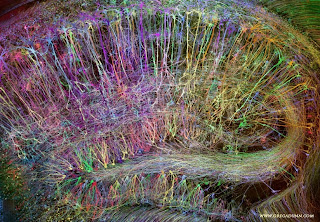Brainbow, a technique that uses fluorescent proteins to distinguish neurons in the brain, has both artistic and scientifically practical applications. Originally developed in 2007 by two Harvard University professors, Jeff Lichtman and Joshua Sanes, Rainbow has since provided the scientific world with a unique and revolutionary way to look at the brain, allowing for scientists to easily distinguish brain patterns and visualizing the ways in which the circuits in the brain work and interact.
Similarly, the many vibrant colors that the Brainbow process produces attract members of the art community at large. It translates to the artistically minded part of society the complex and intriguing phenomena behind the interworking of the brain that those within the field of science regularly experience.
While science is able to turn the brain itself into a work of art, the brain itself creates visually and mentally stimulating work of art on an individual and personal level, by both the use of chemicals that interact with the brain, through drugs like LSD, and by the process of dreaming. LSD, according to Dr. Albert Hoffman who worked extensively with LSD, studying its effects and publishing his findings, commented on the kaleidoscopic nature of LSD hallucinations. LSD works by interacting with the circuits in the brain (the same ones given vibrant distinctions via Brainbow) and effecting the ways in which serotonin is processed and created. These effects create complex hallucinations that bring artistic visuals to life.
Dreaming is another way in which the brain, by still rather unknown neural processes involving REM sleep, creates images and scenarios and imbeds them into a person on an unconscious level.
Iconic psychologist Sigmund Freud, known for his detailed and complex understanding of dreams, believed that interpretation of one's dreams were important and, if done correctly, could reveal many aspects of the person's unconscious mind.
Images:
Dunn, Greg A. "Brainbow Hippocampus." Greg Dunn Design. N.p., n.d. Web. 17 May 2015. <http%3A%2F%2Fwww.gregadunn.com%2Fmicroetchings%2Fbrainbow-hippocampus%2F>.
"LSD: The Cause of Salem Witch Trials?" Psychovalmacology. Word Press, 03 Dec. 2014. Web. 17 May 2015. <https://psychovalmacology.wordpress.com/2014/12/03/lsd-the-cause-of-salem-witch-trials/>.
Mastin, Luke. "Sleep - Types and Stages of Sleep - REM Sleep." Sleep - Types and Stages of Sleep - REM Sleep. N.p., n.d. Web. 17 May 2015. <http://www.howsleepworks.com/types_rem.html>.
"Brainbow." Brainbow. Center for Brain Science, n.d. Web. 17 May 2015. <http://cbs.fas.harvard.edu/science/connectome-project/brainbow>.
"Green Fluorescent Protein - Cool Uses - Brainbow." Green Fluorescent Protein - Cool Uses - Brainbow. Ed. Marc Zimmer. N.p., n.d. Web. 17 May 2015. <http://www.conncoll.edu/ccacad/zimmer/GFP-ww/cooluses0.html>.
Hoffman, Albert. "LSD — My Problem Child." LSD. Trans. Jonathan Ott. McGraw-Hill. Web. 17 May 2015. <http://www.psychedelic-library.org/child.htm>.
"How Do Hallucinogens (LSD, Psilocybin, Peyote, DMT, and Ayahuasca) Affect the Brain and Body?" The Science of Drug Abuse and Addiction. National Institute on Drug Abuse, Feb. 2015. Web. 17 May 2015. <http%3A%2F%2Fwww.drugabuse.gov%2Fpublications%2Fresearch-reports%2Fhallucinogens-dissociative-drugs%2Fwhere-can-i-get-more-scientific-information-hallucinogens-diss>.
McLeod, S. A. (2013). Retrieved from http://www.simplypsychology.org/Sigmund-Freud.html



Hi Katherine,
ReplyDeleteThanks for your post. Your talk on the Brainbow is truly beautiful and surprising. By allowing people to see colored pictures of the brain neurons, this technique is indeed of high importance, both in terms of scientific analysis and artistic enjoyment.